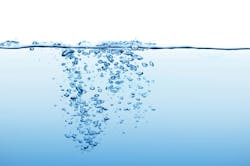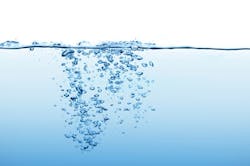Aeration and the production of air continues to account for the majority of electricity costs at wastewater facilities. A treatment plant in Bremervörde, Germany installed a turbo compressor to work alongside positive displacement blowers and help control energy consumption. Norbert Barlmeyer reports.
Wastewater treatment plants are under continuous pressure to meet discharge limits and manage high energy requirements. Facilities with a considerably fluctuating discharge quantity will only be able to function efficiently if the air consumption of aeration basins can be adjusted.
This especially applies for the sewage treatment plant in Bremervörde, Germany, designed for an overall capacity of 30.000 EGW (population equivalents) and with approx. 29.000 EGW nearly used to capacity. Input quantities vary between 1.500 and 3.000 m³/day.
It is obvious that a wastewater treatment system with a wastewater spectrum of 50 up to 100% can only be run with optimal energy utilization, when the selected process air generators adjust fully automatically to all the requirements.
Previsouly, air for the aeration basin was generated by means of positive displacement blowers. These old units were replaced by two Aerzen blowers series Delta Blower.
Technology DetailsThe single-staged, radial Aerzen AT-turbo blowers compress oil free. An integrated frequency converter steplessly adjusts the volume flow to the current requirement. The units are operated in the front door via a water and dust protected Touchscreen-operator control panel and push buttons for Start/Stop/Emergency Off. An optional overriding control regulates the compressor groups steplessly, monitors the operating periods, utilizes the units to capacity uniformly and makes the data exchange to the control room and to the process control system possible. The units provided with four adjusting screws for compensating unevenness of the ground are supplied wired ready for connection. They can be installed without foundation and commissioned immediately after connecting the pressure pipe and the electrical supply. The turbo blowers are driven without gearbox by air cooled high speed permanent magnet motors and are run speed controlled depending on the requirement. In the permanent motors the electromagnetism is combined with a permanent magnetism of the rotor. This rotor does not require any energy for its magnetization. The Aerzen turbos work with rotations up to 42.000 min-1 and with contact free air bearings. In the ideal case they are run in frequency controlled continuous operation or in load-no load operation. During the starting phase first of all the rotor turns on the foil, but with beginning speed generates an air cushion due to its rotation. These air cushion bearings, comparable with hydrodynamic journal bearings, are also called aerodynamic bearings. After achieving a minimum speed the shaft rotates absolutely contact-free and free of wear in the bearings. |
Both units were already speed controlled, so that they could be adjusted to the fluctuating requirement in a range of approx. 35 to approx. 50 Hz. However in their lower performance range the blowers could not cover the even lower load requirement, so that the units were shut down frequently.
Therefore in Bremervörde the facility was looking for a new solution for the process air generation, which had to meet two essential conditions:
- The units of the new concept should be speed controlled and should have a wider performance spectrum, especially in the lower performance range, to be able to cover also the low load requirement
- If possible the units should be run 100% in speed-controlled load-run operation across the entire requirement spectrum.
The initial idea for a new generating concept came following the exchange of experiences between leaders of nearby wastewater treatment plants. At the time they introduced a concept for biologically working wastewater treatment plants, in which turbo compressors generate the required process air.
Heiko Müller, facility operator, says: "We were very much interested in this proposal. Therefore afterwards we started a request for quotation with our requirement data known from the past. Several bidders made proposals for a new concept and sent corresponding offers. In this preselection not only the company which gave the lecture was integrated, but also our previous supplier for many years, Aerzener Maschinenfabrik. After a detailed comparison of all offers received we decided for the offers from Aerzen, so that we could continue the good cooperation."
One year later after a supplier was selected from several bidders, and a Aerzen turbo compressor type TB 100 - 0,6 (driving capacity 75 kW) was installed. The unit has a capacity spectrum of 36 up to 80 m³/min and works as a base load generator for process air supply to the wastewater treatment plant in Bremervörde.
The two Aerzen positive displacement blowers previously used can be connected automatically as stand-by units and as peak load generators. As 75% of the facilty's energy is used to generate process air, the electrical efficiency of the new units was an important requirement.
Before making the decision to purchase the units the facility determined that under consideration of the available depth of the basin, a discharge pressure of 0.4 bar would be sufficient for optimal aeration. Onto this value the impeller of the blower was customized for the highest possible energy efficiency. Higher pressures up to max. 1,0 bar are possible by using corresponding impellers.
All three units, including the new turbo blower and the two existing postive displacement blowers were installed in a separate building. The supply air enters from the outside. A filter mat prevents dust from penetrating into the unit. Warm exhaust air supported by a fan escapes the room. All the units supply via the station directly into the aeration basin. A probe in the basin continuously measures the oxygen content and controls the delivery volume of the process air via the speed of the units. At the end of the treatment process the treated water is discharged into the adjacent river Oste with a purity degree of approx 95%.
In addition the "AT Turbo Generation 5" does not blow the waste heat into the environment, but provides the user with the exhaust air by means of a separate flange for further use. Positive side effect: cool operating rooms, no unnecessary heating of the sludge basin and free-of-charge heat available where it is needed.
"With this concept we meet our requirements optimally and with highest possible energy efficiency. The turbo blower works with its wide performance spectrum as ideal base load unit in spite of our considerably fluctuating input quantities between 1.500 and 3.000 m³/day. Depending on the requirement the Aerzen positive displacement blowers can be connected fully automatically as peak load units," concludes Heiko Müller.
Author: Norbert Barlmeyer is from Aerzener Maschinenfabrik, from Aerzen. For more information on the installation, please email: [email protected]
More Water & WasteWater International Current Issue Articles
More Water & WasteWater International Archives Issue Articles




